AI Agents for Security Questionnaire Automation
Explore the best-rated security questionnaire automation tools with AI agents, plus key features, challenges, and best practices to consider.
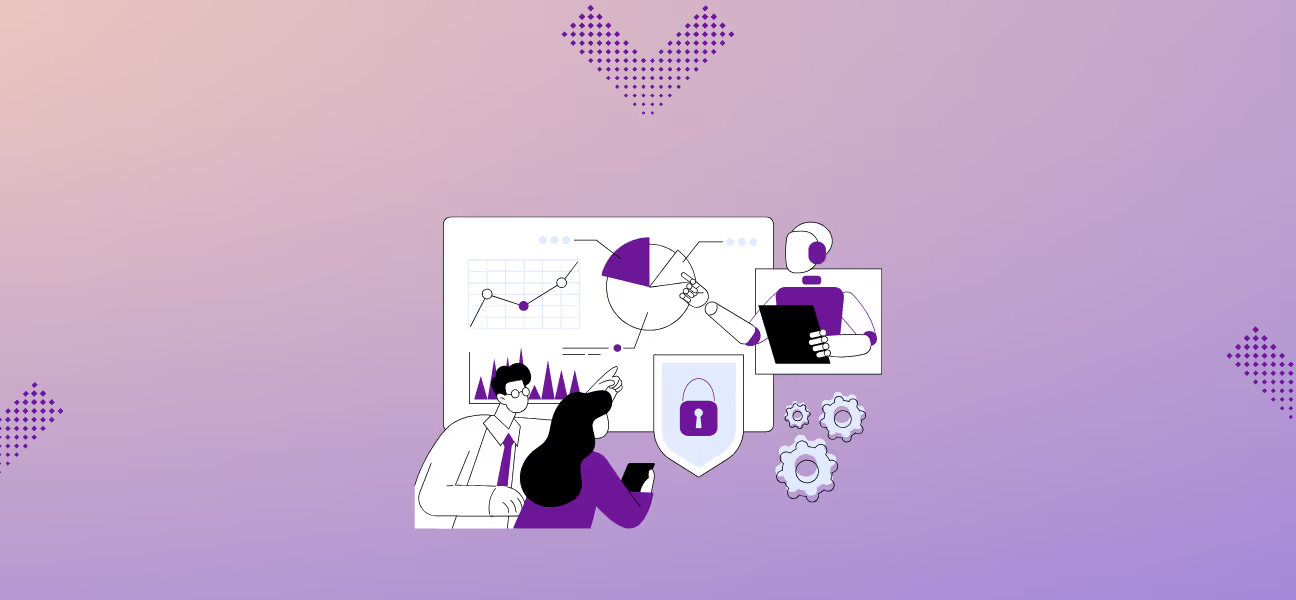
Security questionnaire automation isn’t new, but with AI agents, we’ve moved into a new era of intelligent automation. Traditional tools focused on auto-fill and content reuse, but AI now powers sophisticated workflows, such as drafting tailored responses, mapping to compliance frameworks, and flagging inconsistencies for SME review.
The broader shift to AI agents is already proving valuable: 66% of adopters report higher productivity, with faster decisions, fewer bottlenecks, and better use of team expertise.
This blog explores the best-rated security questionnaire automation tools that use AI agents to streamline the security questionnaire response process. We’ll also walk through the core features to evaluate before choosing a platform, common challenges teams face during implementation, and expert-backed best practices to ensure you get the most out of your investment.
TL;DR
- According to McKinsey, unlike simpler gen AI architectures, AI agents can produce high-quality content, reducing review cycle times by 20 to 60 percent.
- Top-rated security questionnaire automation tools include Inventive AI, Responsive, Loopio, Conveyor, SecurityPal, and SafeBase.
- Look for features like framework coverage, source training, and SME collaboration workflows.
- Best practices include maintaining a centralized content library and adding a manual QA loop before submission.
What Is Security Questionnaire Automation?
Security questionnaires are a routine tool used by companies to assess third-party risk. These questionnaires can range from a few dozen to several hundred questions, covering everything from encryption standards to personnel background checks.
They’re especially common in industries with strict compliance requirements, such as finance, healthcare, and SaaS.
Some of the most widely used formats include:
- SIG (Standardized Information Gathering)
- CAIQ (Consensus Assessments Initiative Questionnaire)
- VSA (Vendor Security Assessment)
Each one aims to standardize how buyers collect evidence from suppliers, but the volume and complexity can quickly become overwhelming for vendors.
Why Automate the Process?
Manually responding to these questionnaires is time-consuming. Security and legal teams often have to dig through policy documents, past responses, and compliance reports just to copy and paste similar answers. That’s not scalable, especially when you’re dealing with dozens of questionnaires a month.
Security questionnaire automation replaces this manual effort with systems that can extract relevant answers and match questions from past responses and known policies.
Modern Security Questionnaire Automation platforms now go a step further by using AI agents to handle the messy, repetitive parts of the process. They deploy AI agents that act as intelligent assistants, able to:
- Interpret varied question formats using NLP
- Link questions to policies, evidence, or previous answers
- Escalate unclear items to the right SME for review
- Improve over time through feedback and reinforcement
These AI agents are now a key layer in hyperautomation strategies, allowing security, legal, and sales teams to handle growing volumes of trust requests without compromising accuracy or response speed.
10 Best-Rated AI Agentic Platforms for Security Questionnaire Automation
Traditional automation tools might help you reuse answers or maintain a content library, but they still rely on manual tagging, formatting, or SME input at nearly every stage.
AI agentic platforms take a different approach. These tools act more like intelligent collaborators than passive databases. They combine natural language processing, document parsing, and reinforcement learning to participate in the questionnaire process actively.
These platforms are increasingly being adopted by compliance, infosec, and presales teams to keep pace with rising security scrutiny—without overwhelming their internal resources.
Below, we’ve curated some of the best-rated AI platforms currently used for automating security questionnaire responses.
1. Inventive AI
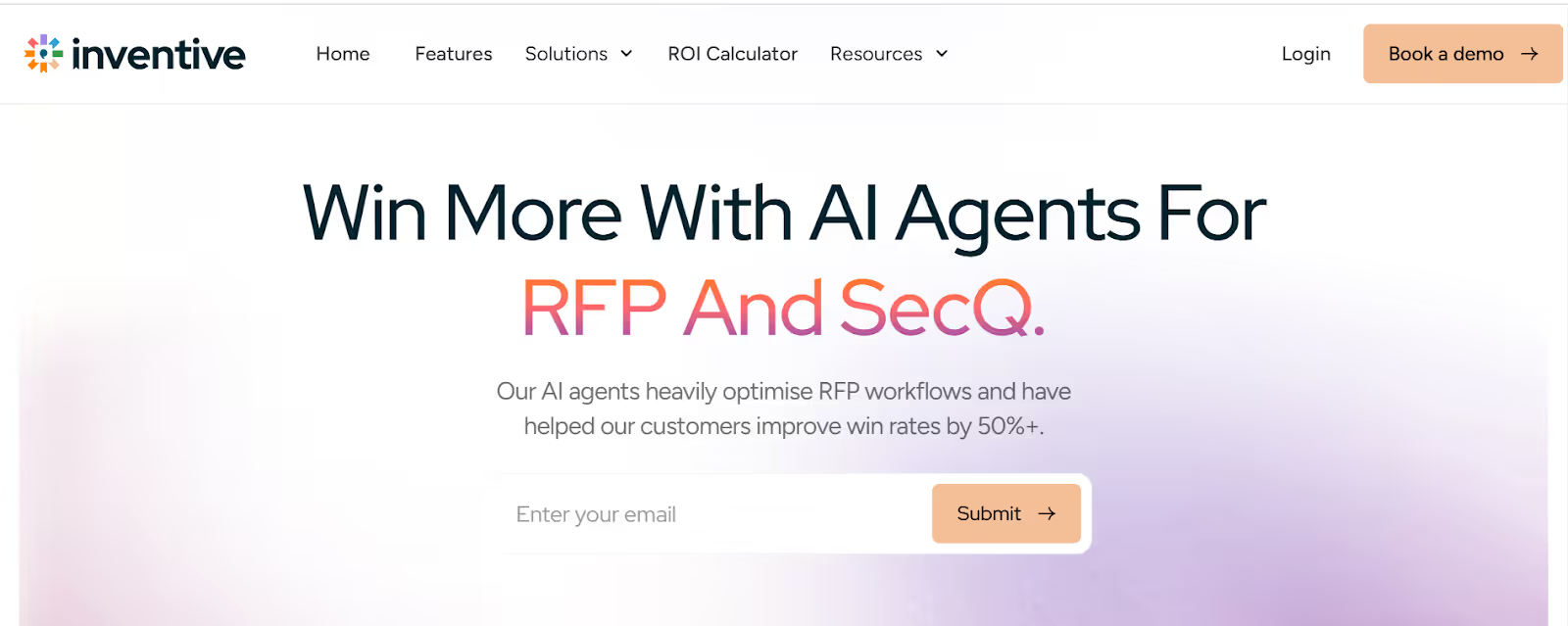
Inventive AI is an AI-powered platform built to automate complex RFPs and security questionnaires. Its purpose-built agent delivers fast, context-aware answers rooted in your organization’s approved knowledge, reducing SME involvement and accelerating trust workflows.
Key Features:
Strategic Agents for Competitive Positioning
Most tools focus narrowly on content generation, but Inventive AI’s agents support the thinking behind strong responses. The brainstorming agent surfaces win themes and value messaging; the competitor research agent scans public data to reveal how rivals pitch, price, and differentiate. Teams can respond with sharper positioning, not just faster text.
Collaboration Built for Cross-Functional Proposal Teams
Security questionnaires often involve sales, legal, security, and technical teams working in parallel. Inventive AI creates a shared workspace with role-based access, task assignment, and real-time progress tracking. Everyone stays in sync without version sprawl or email chaos.
One-Click Automated Answers
Manual response drafting eats into time better spent on strategy and review. With Inventive AI, teams can import questionnaires and generate first drafts instantly, directly mapped to prior answers. This accelerates completion while preserving consistency and accuracy.
AI-Powered Responses
Teams waste hours rewriting the same answers across different security questionnaires. Inventive AI auto-generates responses using your past questionnaires, policy documents, and approved public content. You get accurate, consistent answers up to 10× faster — with less manual effort.
Integrations That Eliminate Silos
Proposal teams often juggle files across Notion, Google Drive, Confluence, and Slack — slowing down coordination. Inventive AI connects directly to these platforms, pulling in relevant content and syncing updates in real time. Collaboration becomes fluid, centralized, and far less error-prone.
Pros
- Cutting-Edge AI Architecture: Purpose-built for generative AI with 70% more Efficiency.
- Industry-Adaptive Responses: Learns from past content and adapts to niche industries and formats.
- Real-Time Collaboration: Teams can build and review responses together with full transparency.
- High Accuracy: Answers are grounded in verified internal sources, no hallucinated content.
Cons
- Requires Initial Setup: Teams need to connect internal knowledge sources and train AI agents to get full value.
Best For: Security and presales teams seeking a fast and reliable AI agent to manage high volumes of security questionnaires with complete control and context.
Testimonials
“Future of RFP/RFI/security questionnaire responses! Saves our team a ton of time.
A lot of great features. User experience is extremely intuitive and the team is very responsive.” Ben Hou (Head of Solutions at Outreach)
User Rating
2. Responsive (formerly RFPIO)
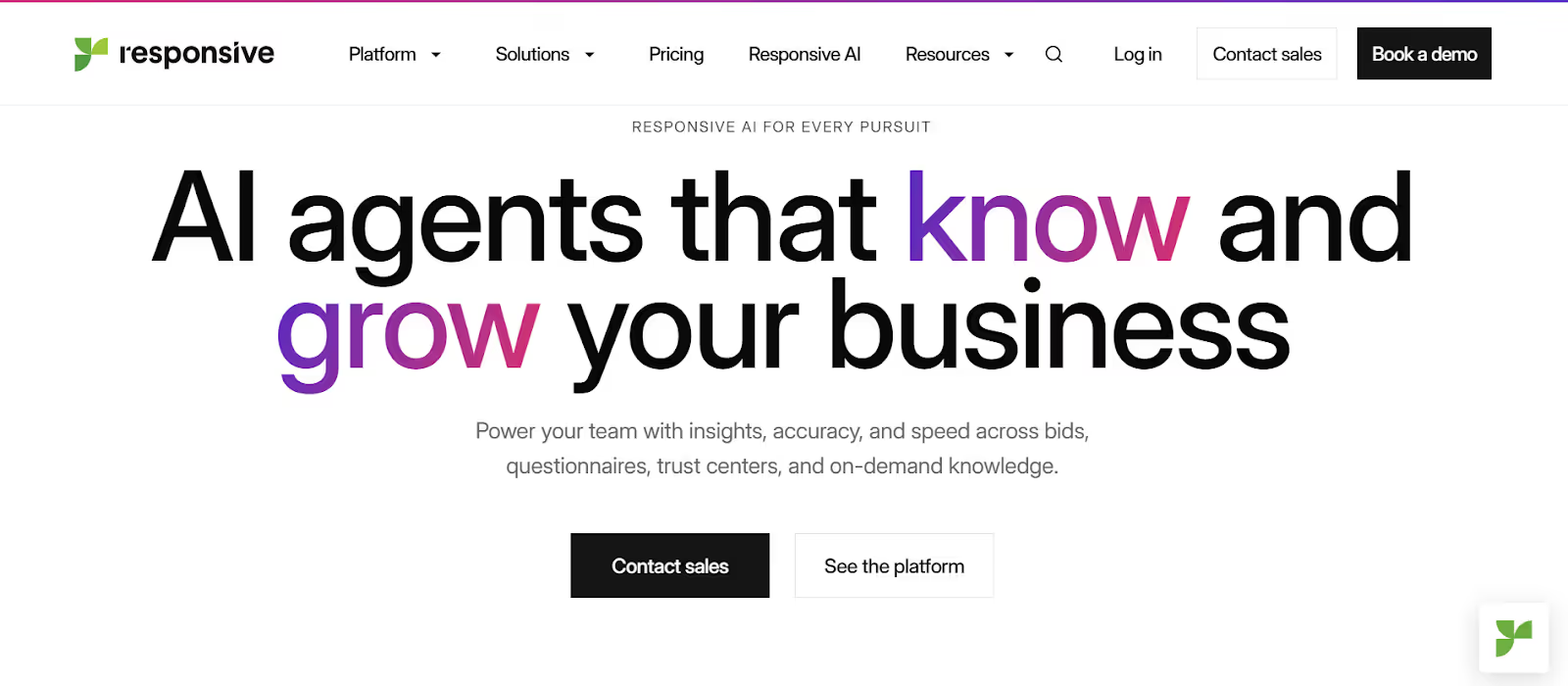
Responsive is an AI-powered platform designed to automate complex vendor security questionnaires (VSQs) such as SIG, VSAQ, CAIQ, and NIST 800-171. It reduces repetitive tasks, speeds up compliance workflows, and helps teams complete accurate responses without overwhelming internal SMEs.
Key Features:
- AI-Enabled Content Management: Surfaces the best answers from your internal knowledge base to improve speed and consistency.
- Multi-Format Intake: Imports questionnaires in Word, Excel, PDF, and other formats to eliminate formatting delays.
- Collaboration Tools: Enables in-platform communication, task assignments, and streamlined SME review.
- Integrations: Connects with CRMs, cloud storage tools, Microsoft Office, web browsers, and sales enablement platforms.
Pros
- Real-time team collaboration and external reviewer access
- Solid CRM and cloud storage integrations across business functions
Cons
- No free trial and advanced features are add-ons.
- Workflow rules require setup time and regular content maintenance.
User Rating
Best For: Teams managing a high volume of vendor security questionnaires who need speed, accuracy, and strong alignment with compliance workflows.
3. Loopio
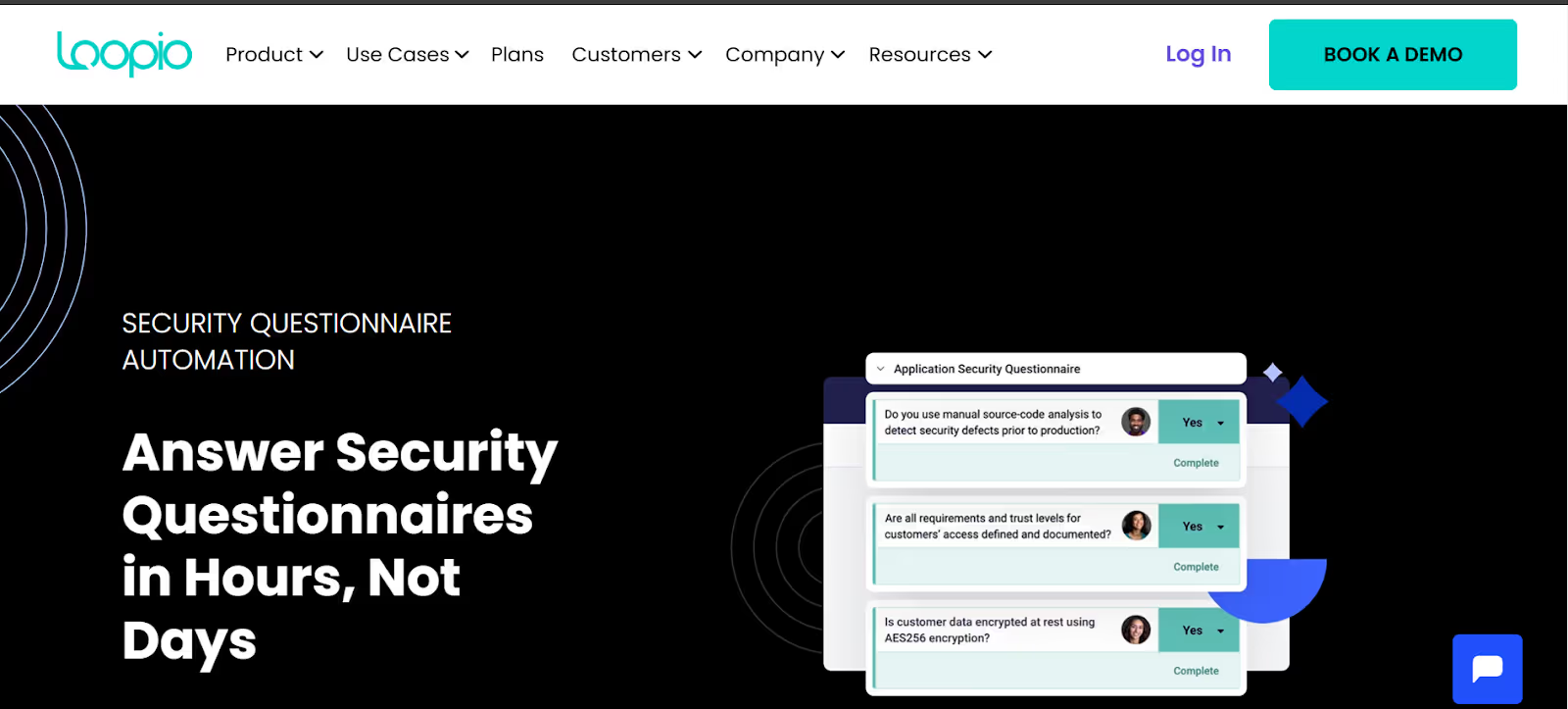
Loopio is a legacy leader in RFP and security questionnaire response management that is now adopting AI capabilities to enhance its well-established workflows. Built on years of structured content management experience, Loopio brings automation into familiar, reliable processes for security and sales teams.
Key Features:
- Intelligent Answer Automation: Detects questions in new documents, suggests the best-matched answers, and exports responses back into the original format.
- Content Library: Empowers non-technical users to respond using a pre-approved, up-to-date repository of security and compliance information.
- Project Tracking & Workspace: Enables seamless collaboration across sales and security teams with shared workspaces, role-based access, and real-time notifications.
- Content Review Tools: Keeps your library clean and current by surfacing outdated answers and automatically updating content after each project.
- Automated FAQ Responses: Quickly fills in answers to common questions, freeing up SMEs to focus on more complex responses.
Pros
- Clean, modern UI that’s easy to adopt from day one.
- Powerful collaboration tools for cross-functional teams.
Cons
- AI accuracy depends on a mature content library.
- Onboarding still requires structured training.
User Rating
Best For: Organizations that want to simplify repetitive questionnaire workflows with a structured content library and AI-assisted recommendations.
4. Conveyor
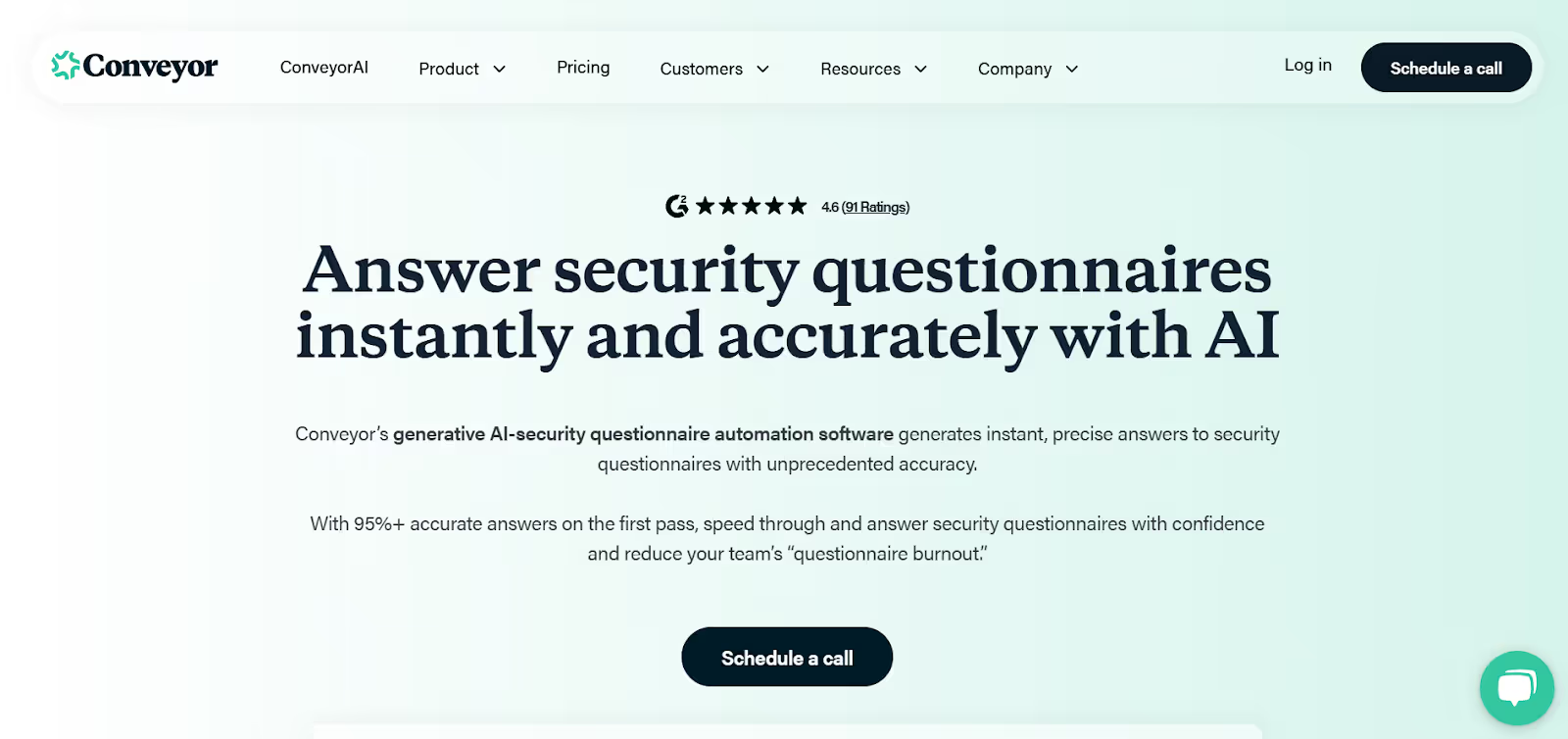
Conveyor is an AI-driven platform purpose-built for automating security questionnaire responses with speed and accuracy. Its generative AI reads from internal and external sources to provide instant, source-cited answers, while its Trust Center supports secure document sharing and customer transparency.
Key Features:
- Generative AI Answering: Automatically fills out entire questionnaires with cited sources for unmatched accuracy and minimal rewriting.
- Source-Agnostic Intelligence: Learns from documents, past Q&As, and even external web content, with no manual content library upkeep required.
- Multi-Format Support: Instantly processes Excel, Word, PDF, and portal-based questionnaires for seamless import and export.
- One-Click Auto-Completion: Enables fast, full auto-completion for portal-based questionnaires, eliminating the need for copy/paste workflows.
- Sales & Workflow Integrations: Syncs with Salesforce and Slack to keep presales teams in flow and tie security responses to revenue.
Pros
- Zero-maintenance content library driven by source material.
- Integrated trust center auto-links requested policies.
Cons
- The complex interface can overwhelm new users.
- Domain-based pricing may be costly for some organizations.
User Rating
Best For: Sales-driven security teams who need high-volume, high-accuracy automation that ties directly to deal velocity.
5. SecurityPal

SecurityPal offers a hybrid approach to security questionnaire automation by combining certified security analysts with AI-driven tools. Their Security Questionnaire Concierge service delivers completed responses—often within 24 hours—with multilingual support and real-time tracking.
Key Features:
- Security Questionnaire Concierge: Blends AI automation with expert review to deliver questionnaires in under 24 hours.
- Certified Analysts + AI: Human analysts work alongside AI to ensure accuracy and compliance.
- Multilingual Support: Enables support for international customers across multiple languages.
- Real-Time Tracking: Provides live progress updates via an intuitive dashboard.
- In-App Collaboration: Lets users interact with analysts directly in-platform to clarify inputs and maintain alignment.
Pros
- A hybrid AI-plus-expert model ensures near-perfect accuracy.
- Multilingual support from certified cybersecurity professionals.
Cons
- Higher costs compared to pure-software solutions.
Best For: Teams that need fast, expert-validated questionnaire responses without sacrificing accuracy or human oversight, especially when working with global customers.
6. SafeBase

SafeBase combines a centralized Trust Center with powerful AI-powered Questionnaire Assistance to automate the security review process. It gives buyers instant, self-serve access to your security documentation and generates accurate, cited answers to incoming questionnaires. With deep integrations, real-time analytics, and CRM automation, SafeBase helps security teams scale without getting buried in manual tasks.
Key Features:
- AI-Powered Questionnaire Assistance: Automates questionnaire responses with contextual, accurate, and cited answers.
- Centralized Trust Center: Securely shares compliance documents, certifications, and policies with prospects via a self-serve portal.
- Seamless Integrations: Collaborate with SMEs using tools like Slack, Teams, Salesforce, Jira, and a Chrome Extension for direct uploads.
- Custom CRM Rules Engine: Automatically invite, assign, or revoke access to documents based on deal stage and user role.
- Analytics & Deal Intelligence: See which buyers engage with your Trust Center, connect security work to revenue, and prioritize questionnaires tied to high-value deals.
Pros
- Comprehensive analytics track security-influenced revenue.
- Branded Trust Center enables secure, selective document sharing.
Cons
- Limited multi-product support and document management capabilities.
G2 Rating
- 4.7
Best For: Security, sales, and GRC teams that want to unify Trust Center transparency with AI-driven response automation.
7. Arphie

Arphie is an AI-powered platform designed to automate security questionnaire responses, using advanced natural language processing to generate highly accurate, context-driven answers. It focuses on streamlining the proposal process for teams handling large volumes of RFPs and compliance inquiries.
Key Features:
- Intelligent Response Generation: AI-driven generation of responses based on historical data and content libraries.
- Contextual Adaptation: Real-time customization of responses based on current requirements and user inputs.
- Document Integration: Seamless integration with cloud platforms like Salesforce, Google Drive, and Microsoft Teams.
- Data Security: High-level encryption for data protection during document management and sharing.
Pros:
- Fast, high-quality responses driven by AI.
- Real-time customization of proposals and questionnaires.
- Seamless integration with popular business tools.
Cons:
- Initial setup may require significant time investment.
- Some advanced features are limited to premium plans.
User Rating
8. Drata
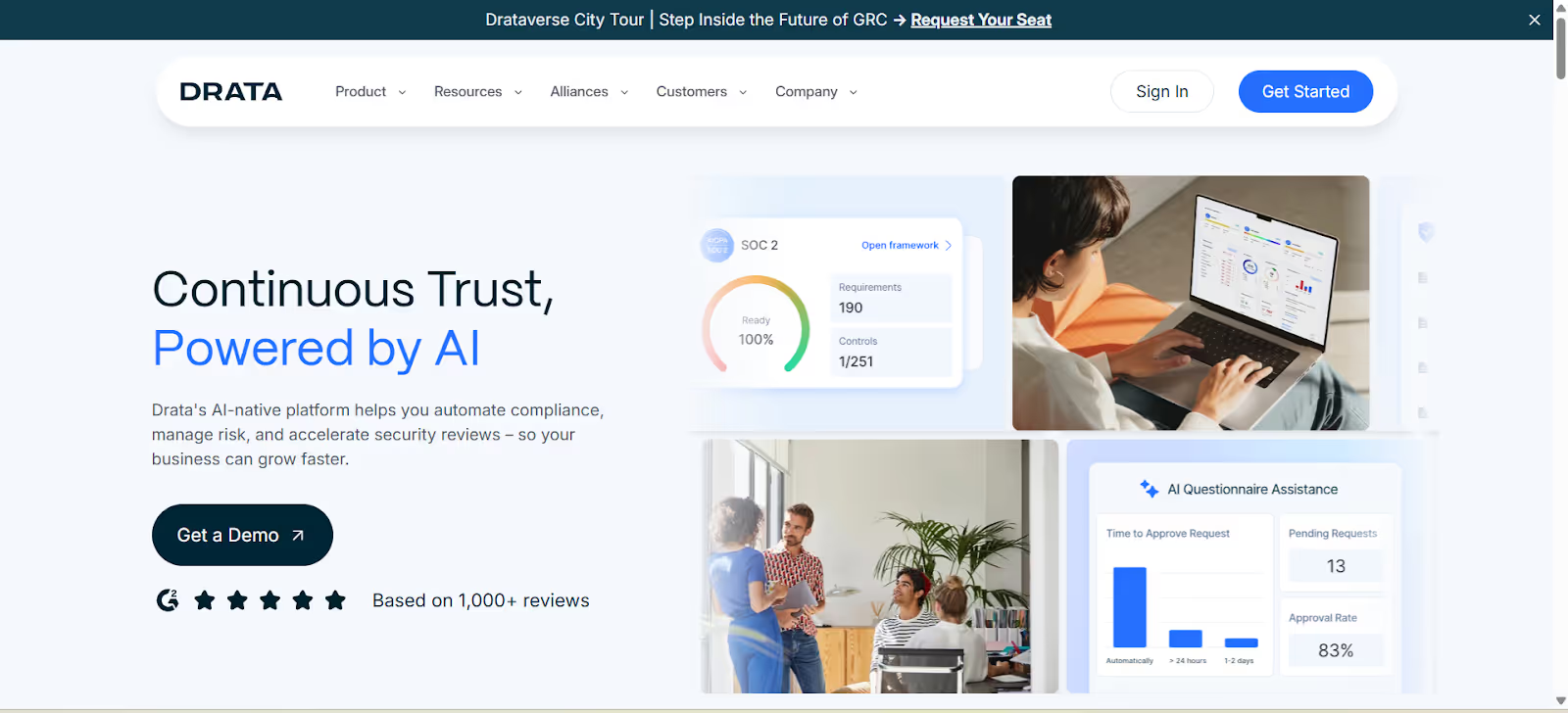
Drata is an AI-powered platform designed to streamline the response generation for security questionnaires and automate compliance workflows. It focuses on security, risk management, and regulatory compliance, offering a comprehensive solution to ensure timely, compliant responses.
Key Features:
- Automated Response Generation: AI-driven tool that automates responses to complex security questionnaires, ensuring accurate and consistent answers.
- Continuous Compliance Monitoring: Tracks ongoing compliance for certifications like SOC 2, ISO 27001, and others, ensuring your team stays audit-ready.
- Easy Integration: Seamlessly integrates with a wide range of business tools such as Salesforce, Slack, and G Suite.
- Audit-Ready Reports: Generates compliance reports that align with industry regulations and standards.
Pros
- Strong focus on continuous compliance.
- Seamless integration with major business tools.
- Automated responses with real-time monitoring.
Cons
- Primarily focused on compliance-heavy industries, limiting its use for general RFP automation.
- May require additional customization for certain industry-specific needs.
Best For
Compliance and security teams seeking to automate security questionnaire responses and maintain continuous compliance.
G2 Rating
- 4.6/5
9. Vanta
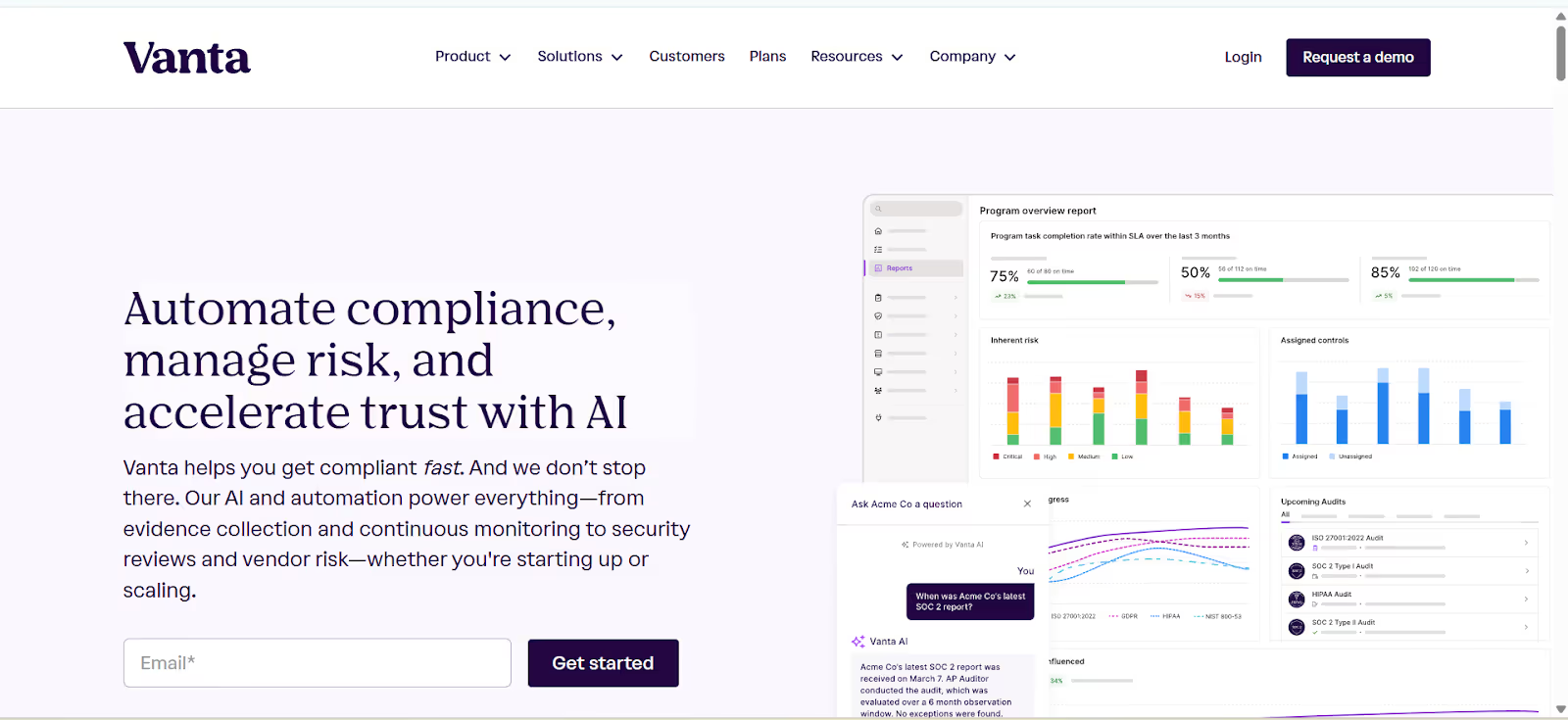
Vanta is an AI-driven platform designed to help businesses automate and streamline security questionnaire responses. It focuses on providing high accuracy in security and compliance workflows, with a heavy emphasis on scalability and security standards.
Key Features:
- Automated Response Generation: Speeds up the completion of security questionnaires by auto-generating answers.
- Compliance Frameworks: Ensures answers align with frameworks like SOC 2, ISO 27001, and GDPR.
- Audit-Ready Responses: Keeps your team ready for audits by tracking compliance across all responses.
- Cloud Integration: Syncs seamlessly with Salesforce, Slack, and other CRM systems.
Pros
- Strong compliance alignment with top security standards.
- Automated audit-ready responses ensure quick compliance.
- Scalable solution for growing businesses.
Cons
- Limited to security-focused RFPs and questionnaires.
- Some users find the setup process cumbersome.
G2 Rating:
- 4.8/5
10. UpGuard

UpGaurd is a comprehensive security risk management platform that automates the process of answering security questionnaires and ensures compliance across various regulatory frameworks. Designed for enterprises, UpGuard leverages AI and automation to streamline the security review process, providing teams with faster, more accurate responses and reducing the complexity of security assessments.
Key Features:
- Automated Security Questionnaire Responses: UpGuard’s AI-powered engine automatically generates responses to security questionnaires, saving time and ensuring consistency.
- Continuous Security Monitoring: The platform continuously monitors your organization’s security posture, offering real-time alerts and reporting.
- Compliance Tracking: Tracks and ensures alignment with key standards such as SOC 2, ISO 27001, and GDPR.
- Centralized Risk Management: Allows teams to manage and mitigate security risks in one place, with a centralized dashboard and automated workflows.
Pros
- Comprehensive risk management for both internal and third-party assessments.
- AI-driven automation reduces manual effort and speeds up response times.
- Real-time monitoring and alerts to keep your security posture up-to-date.
- Strong integrations with popular business and cloud platforms.
Cons
- Requires significant configuration and setup time for full utilization.
- Can be expensive for smaller teams or companies with lower security compliance needs.
G2 Rating:
- 4.6/5
Each of these platforms brings a distinct approach to security questionnaire automation, ranging from pure-play AI agents to hybrid concierge models and Trust Center integrations.
While some tools focus on rapid intake and smart content reuse, others emphasize buyer transparency, multilingual support, or deep analytics tied to revenue. Choosing the right solution depends on your team’s volume, complexity, and workflow preferences.
How to Choose the Best Tool
Selecting the right AI-powered security questionnaire automation platform requires more than looking at speed or automation claims.
- Here are a few things to consider:
Source Training: Ensure the platform leverages past questionnaires, policy documents, and compliance frameworks for accurate, context-aware answers. - SME Collaboration Workflows: Look for approvals, annotations, and change tracking to maintain accountability and audit readiness.
- Framework Coverage: Confirm support for relevant standards such as SOC 2, ISO 27001, NIST CSF, and HIPAA.
- Integration Capabilities: Check connections with CRM, cloud storage, productivity apps, and GRC tools to streamline workflows.
- Export Options: Verify the platform can handle Excel, portal submissions, and trust profiles for flexible delivery.
Once you’ve identified the right platform, the next step is to understand which features truly drive efficiency, accuracy, and compliance. These are the capabilities that distinguish basic automation from intelligent AI-driven workflows, and understanding what to prioritize will help you maximize the value of your investment.
7 Features to Look For in a Security Questionnaire Automation Tool

When evaluating security questionnaire platforms, focus on features that reduce response time without compromising accuracy or oversight. The best tools go beyond autofill—they embed security and sales workflows into your existing processes.
1. Source Training
Top platforms should learn from your organization’s past questionnaires, security policies, and control frameworks. This enables more accurate AI responses and minimizes manual effort.
2. SME Workflows
Look for features like role-based approvals, in-line annotations, and change tracking. These allow subject matter experts to contribute without leaving the tool or risking version sprawl.
3. Framework Coverage
Your tool should support mappings across major frameworks like SOC 2, ISO 27001, NIST CSF, and HIPAA. This ensures that answers stay aligned with your actual certifications and audit trails.
4. Integration Support
Integrations with tools like Salesforce, Jira, and GRC systems help streamline intake, assign owners, and sync questionnaire data across your internal pipeline.
5. Export Flexibility
Security reviews often arrive in clunky spreadsheets or require submission via third-party portals. Strong tools offer export support to Excel, portals, and trust profile formats, reducing the need for last-mile formatting.
6. Response Quality Controls
The tool should flag incomplete answers, outdated references, or conflicting statements automatically. Some platforms also offer in-tool citation, so every response is backed by a traceable control or policy source.
7. Audit Readiness & Version History
Built-in version history helps maintain a clean audit trail across questionnaire updates. This is essential for regulated industries or high-stakes compliance cycles where reviewers may revisit previous submissions.
Challenges in Automating Security Questionnaires
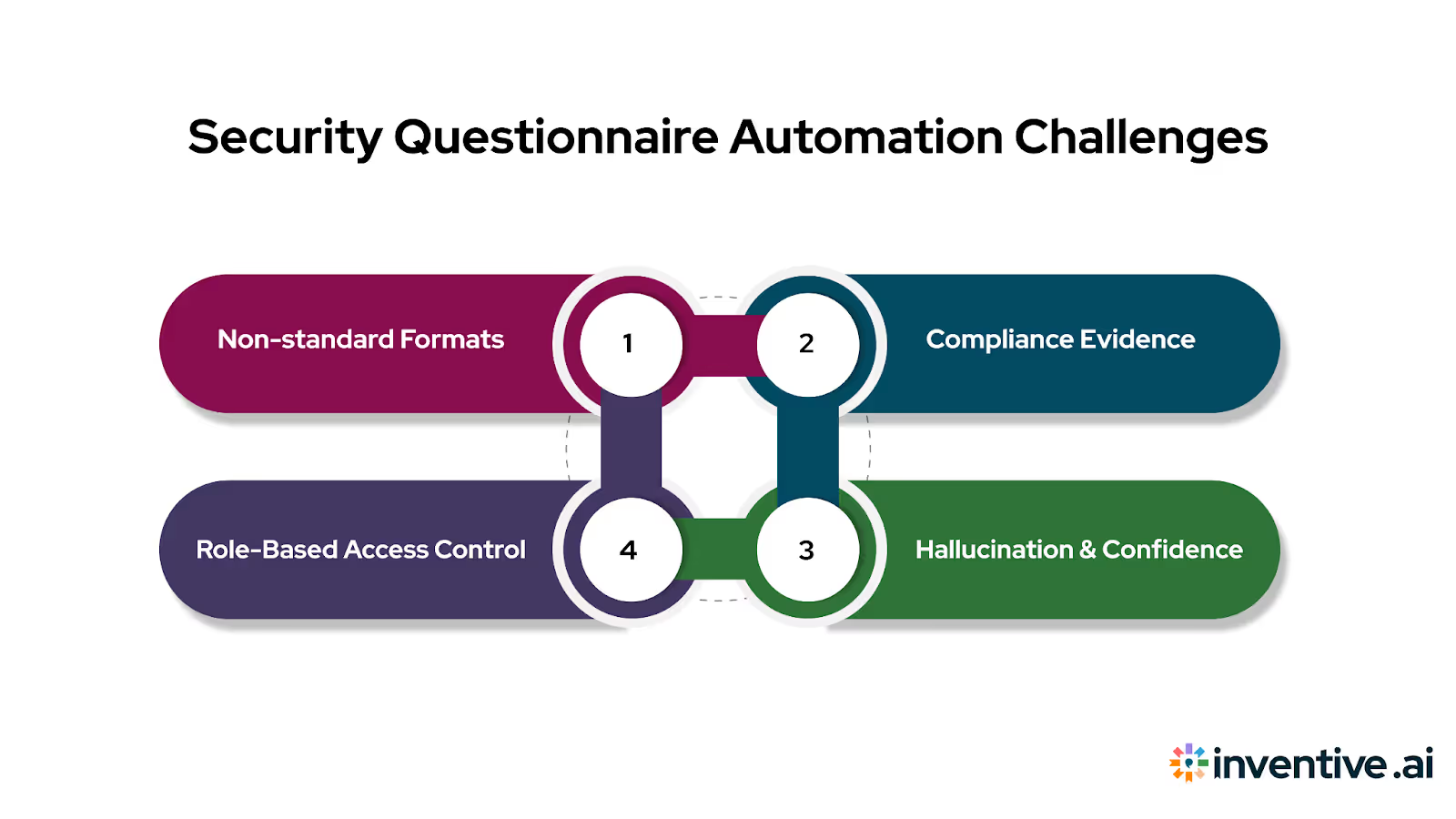
Like any technology shift, using AI agents to automate security questionnaires introduces its own set of risks. Before rolling out a solution, it’s essential to understand the technical and operational pitfalls that can limit accuracy, security, and compliance. Below are some common challenges to anticipate and address early.
1. Non-standard Formats and Jargon Across Buyers
Every buyer uses a slightly different questionnaire format, like Excel grids, Word docs, and custom security forms. Field names, question logic, and terminology vary by industry and even by region.
For AI automation, this introduces parsing and mapping inconsistencies, especially when the tool must interpret context-sensitive terms like “data isolation” or “shared responsibility.”
Standardizing inputs or pre-processing questions often becomes a prerequisite.
2. Compliance Evidence Becomes Outdated Quickly
Many answers reference audit reports, policy documents, or technical configurations that evolve over time. For example, a SOC 2 control ID may change, or the evidence for encryption at rest may point to outdated KMS configurations.
Without a tightly managed document source of truth, automated tools risk inserting stale or non-compliant responses. Regular synchronization with compliance teams and GRC platforms is crucial to maintaining accuracy.
3. Hallucination and Confidence Limits in AI Responses
Even advanced LLMs can generate syntactically correct but factually wrong answers, especially when the underlying documents lack specificity. For instance, an AI might fabricate the name of an encryption standard or misstate how customer data is segmented.
Confidence scores or evidence citations are helpful, but not universally available. Human-in-the-loop review is necessary for high-risk or high-revenue questionnaires.
4. Privacy and Role-Based Access Control
Security questionnaires often require referencing sensitive internal docs (e.g., architecture diagrams, penetration test summaries). Routing these documents through an AI model—especially a third-party vendor—introduces governance and access control issues.
Role-based permissioning, redaction workflows, and data residency assurances become non-negotiable requirements in enterprise environments.
Best Practices for Using AI in Security Questionnaire Response
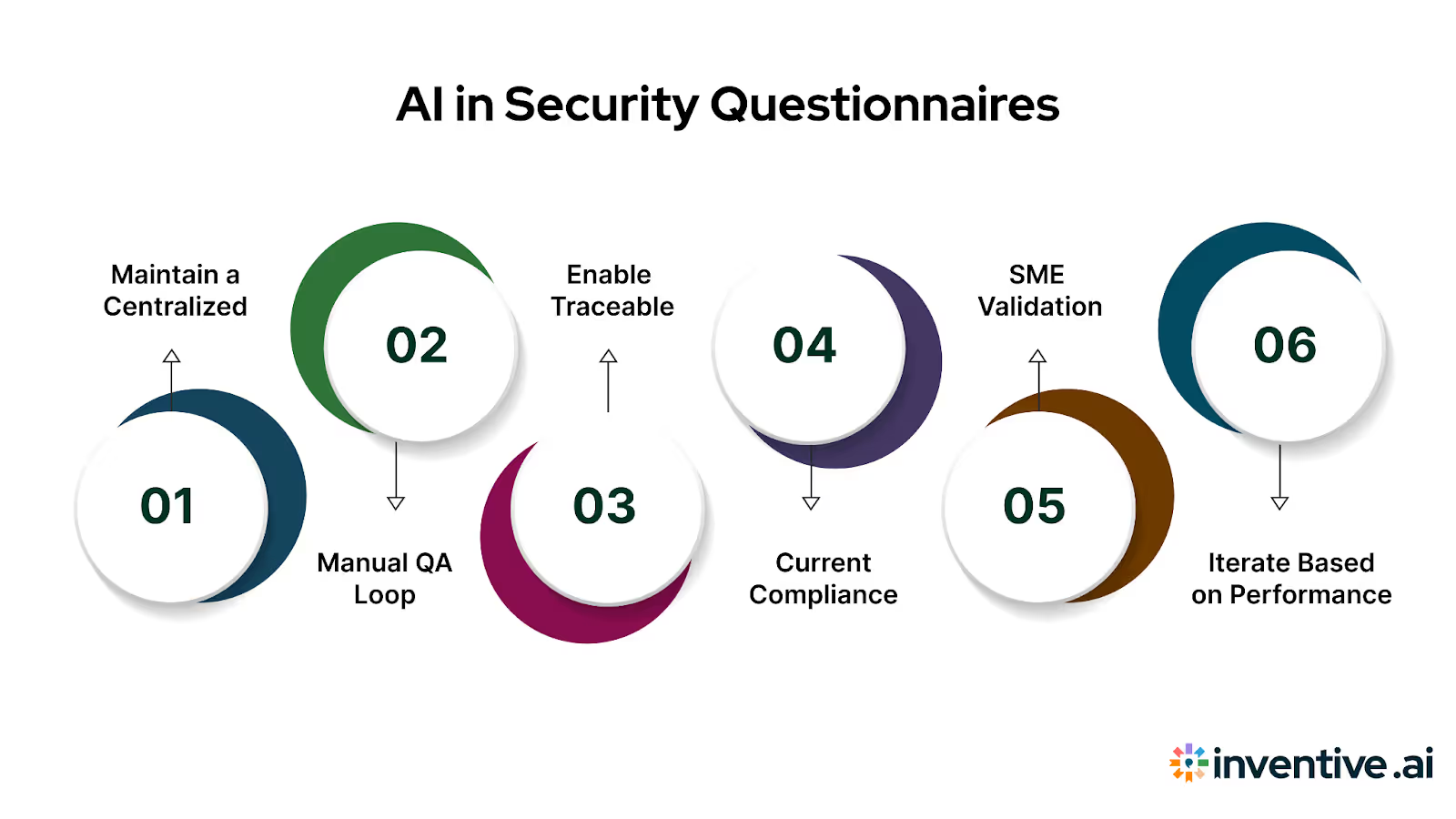
AI can accelerate security questionnaire responses, but only when it's implemented with the right safeguards. Without structured workflows, version control, or ongoing oversight, you risk introducing inaccuracies into regulated customer conversations.
Below are proven best practices to help your team get the speed benefits of AI without compromising on precision, accountability, or compliance integrity.
1. Maintain a centralized, versioned content library: Build a single source of truth with approved answers, mapped controls, and compliance citations. Regularly audit and update it to reflect the current security posture and evolving customer expectations.
2. Always include a manual QA loop: AI should assist, not replace, subject matter experts. Final submissions must go through human review to catch misinterpretations, update expired references, and ensure language aligns with your brand and compliance positioning.
3. Enable traceable version control: Track each response iteration like what was edited, who approved it, and when it was submitted. This protects against miscommunication with customers and supports audit readiness.
4. Sync AI with your current compliance status: Outdated evidence is a common risk. Ensure your AI agent pulls from the latest policies, pen test reports, and third-party attestations. Avoid legacy claims that no longer apply to your environment.
5. Establish SME validation workflows: Use collaborative tools that notify domain owners when their input is required. AI can draft, but only SMEs can verify control ownership, implementation specifics, and regulator-facing language.
6. Benchmark and iterate based on performance: Track metrics like submission time, approval rate, and revision cycles. Use this data to improve prompt quality, retrain AI on better examples, and identify recurring friction points.
The Future of Questionnaire Automation: What’s Next?
Platforms like Inventive AI are redefining how RFPs and security questionnaires are handled. The industry is moving beyond simple content reuse toward a future of intelligent, autonomous systems. Imagine a world where you don’t need to lift a finger—not even for minor edits.
As soon as a questionnaire lands in your CRM or inbox, the AI agent gets to work. It can interpret varied question formats, link questions to internal policies, and escalate unclear items to the right SME for review, all within minutes. The system auto-generates high-quality, human-like responses rooted in your organization's approved knowledge.
You just sit back and review. 300 questions, answered in record time, without the manual grind. This shift allows security, legal, and sales teams to manage a growing volume of trust requests without compromising accuracy or speed.
Conclusion
Responding to security questionnaires used to be a bottleneck—manual, repetitive, and disconnected from pipeline strategy. With the best-rated security questionnaire automation tools, the process is becoming a strategic edge. You’re not just answering faster—you’re answering smarter, aligning your security posture with buyer expectations, and freeing up teams to focus on higher-value work.
Inventive AI’s specialized agents are designed to do more than just speed up security questionnaire responses; they enhance how you compete. The brainstorming agent helps your team shape win themes and positioning strategies specific to each opportunity.
The competitor research agent scans public materials to uncover how rivals are pitching and pricing, giving you a strategic edge. And the customer research agent analyzes buyer websites and content to align your messaging with their security language.
See how Inventive’s AI Agents give your team a strategic edge. Book a demo today.
FAQs About Best-Rated Security Questionnaire Automation Tools
1. Can AI tools fully automate security questionnaire responses without human input?
Not entirely. While AI can draft up to 80–90% of responses using pre-trained content, a manual QA loop is essential for validating context, compliance accuracy, and aligning with deal-specific nuances.
2. How does AI handle customer-specific formats and terminology?
Leading platforms are trained on past questionnaire submissions, policy documents, and compliance controls. Some also allow custom token training or glossary mapping to decode client-specific jargon and map it to your internal content structure.
3. What security and privacy risks come with uploading sensitive documentation into these tools?
Ensure your chosen platform supports granular access controls, encrypted storage, and role-based permissions. Some platforms also offer audit logs and auto-expiry for shared documents to mitigate long-tail exposure.
4. How often should you update your content library for best AI performance?
Every quarter at a minimum, or immediately after any audit, pen test, or policy change. AI tools perform best when trained on accurate and current compliance artifacts—outdated inputs risk propagating false claims.
5. Is there a standard compliance framework that all tools support?
Most tools cover core frameworks like SOC 2, ISO 27001, and HIPAA. Advanced platforms also support cross-mapping across multiple standards (e.g., NIST CSF, FedRAMP) and allow tagging responses by framework for easier reuse.

